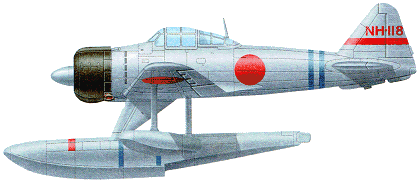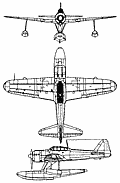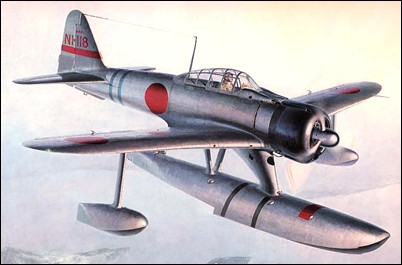|
| Japan was the only nation to produce
and deliver into service float-equipped
single-seat interceptor
fighter seaplanes (the British Spitfire
float adaptation did not progress
beyond the experimental stage).
When in 1940 the Japanese navy initiated
the design of a new interceptor
seaplane (the Kawanishi N1K1 Kyofu,
or 'Rex'), the need was also expressed
for a stopgap aircraft and the Nakajima
company was instructed in February
1941 to develop a float-equipped version
of the excellent Mitsubishi A6M2
Zero naval interceptor. As evidence of
Japan's long-standing plans for territorial
expansion through the Pacific, it
had been recognized that in the inevitable
'island-hopping' war there would
be few ready-made air bases from
which to provide air cover during the
occupation of the smaller islands, and
that the construction of runways would
be impractical. Although equipped
with almost a dozen aircraft-carriers,
the Japanese would be unable to use
them in support of every single island
invasion.
After removing the wheel landing
gear and fairing over the wheel wells
of a standard A6M2, Nakajima
mounted a large float under the fuselage
by means of a forward-raked central
pylon and a pair of V-struts below
the cockpit; two cantilever stabilizing
floats were also mounted under the
wings. The standard Zero gun armament
was retained, and the first prototype
was flown on 7 December 1941,
the day on which the Japanese navy
attacked Pearl Harbor.
Entering production as the Nakajima
A6M2-N and codenamed 'Rufe'
by the Allies, the new fighter still displayed
a creditable performance,
being first issued to the Yokohama
Kokutai and deployed to Tulagi in the
Solomons where the Japanese had first
landed during the Battle of the Coral
Sea. However, almost all the 'Rufes'
were destroyed in a strike on the seaplane
base by 15 Grumman F4Fs from
USS Wasp on 7 August 1942. Better
success attended the 'Rufes' which
fought in the later Aleutian campaign,
but losses soared as soon as American
fighter strength could be built up. During
the final year of the war, when
American heavy bombers and naval
aircraft opened their great attacks on
the Japanese homeland, 'Rufes' of the
Otsu Kokutai, based on Lake Biwa,
were thrown into the battle as interceptors
in defence of Central Honshu
but suffered very heavy losses. Total
production of 'Rufe' amounted to 327
before being halted in September
1943.

| CREW | 1 |
| ENGINE | 1 x Nakajima "Sakae-12", 705kW |
| DIMENSIONS |
| Wingspan | 12 m | 39 ft 4 in |
| Length | 10.1 m | 33 ft 2 in |
| Height | 4.3 m | 14 ft 1 in |
| Wing area | 22.44 m2 | 241.54 sq ft |
| PERFORMANCE |
| Max. speed | 435 km/h | 270 mph |
| Cruise speed | 300 km/h | 186 mph |
| Ceiling | 10000 m | 32800 ft |
| Range | 1150 km | 715 miles |
| Range w/max.fuel | 1780 km | 1106 miles |
| ARMAMENT | 2 x 20mm cannons, 2 x 7.7mm machine-guns |
 | A three-view drawing (752 x 1146) |
| Anonymous, 12.05.2021 17:42 Many nations, including Britain and the U.S., explored the concept of a water-borne fighter. The British mounted a Spitfire on twin floats, while the U.S. Navy tested a Grumman "Wildcat" similarly mounted on twin floats. However, those fighters remained no more than experimental prototypes. Only the Japanese actually produced such aircraft in quantity and placed them into operation. In addition to this aircraft, Kawanishi designed and built a float-plane fighter from scratch; the N1K1 "Kyofu" (known to the Allies as "Rex"). However, only 97 of the latter were ever built due to the changing course of the war, in which the Japanese no longer required float-plane fighters to operate from island bases, but instead required interceptors for use over the Japanese Home Islands. As a result, the N1K1 was redesigned as a land-based intercepter, the N1K2 "Sheden-Kai", known to the Allies as "George". reply | | luis ceberg, e-mail, 17.02.2013 03:00 lo que no se menciona es que los nipones usaron la patente del motor PW de 14 cilindros parecido al del DC-3. reply |
| zhuma, 21.06.2011 04:57 also would like to enter your community, hope it is possible:-) Cya around, best regards, Alex! reply | | bombardier, e-mail, 24.05.2011 19:10 The seaplane interceptor concept was outdated from the start but using the Rufe as catapult launched seaplana wasn't a bad idea reply | |
| | Duane Rose, e-mail, 26.04.2011 19:40 How do you pronounce "rufe" Is it roof or rough? reply | | Ben Beekman, e-mail, 22.02.2011 21:08 I have to agree with Griffin about the identity of the floatplane at the Adm. Nimitz Museum. I was there back in the late 1960's when they had a Kawanishi N1K Kyofu (Rex) on display out in the open air. It was in excellent condition and whoever bought it later on might have wanted to restore it to flyable condition.
Only 97 Rex's were ever built making them rarer and probably even more expensive to obtain than the Rufe. reply | | yakpilot, e-mail, 15.02.2011 23:37 There is a fine example of this aircraft in storage at the National Museum of Naval Aviation. This aircraft is not on display and cannot be viewed by the public. reply | | DebtMan, e-mail, 18.10.2010 06:12 Effectively Jim,a sole Rufe was captured by Russia in Manchuria in 1945 october and was tested during 5 months and finally in 1946 march the plane was scrapped reply | | Jim, 24.03.2010 23:45 Was any rufe captured by russians? reply | | Griffin Murphey, e-mail, 07.07.2009 07:07 It was not a Rufe, it was a Rex (Kyofu). They sold it and the SBD to buy the PT boat. reply | | John D, e-mail, 22.06.2009 18:51 There is an intact,original, unrestored....in very good condition "Rufe" at the Pacific War Museum in Fredricksburg, Texas. The museum is directly behind the Admiral Nimitz Museum on Main St. The Rufe was not on common display the last time I was there in 2004 but, a docent took me into the storage area to view it because of intense interest. It was magnificent and I have photos of it. reply | | delaney, 23.06.2007 04:35 my grandfather flew beaufighters over indonesia and there sqn actually nailed quite a few rufes aswell as petes! didnt realise it was essentially a zero..... reply | | Tim, e-mail, 28.01.2007 21:12 Is there anywhere in North America or even in the entire world that one of the A6M2-N floatplane has been preserved and put on display?
Thank you reply |
| Alexvath, e-mail, 11.02.2007 02:22 Hello, my name is Alex, i'm a newbie here. I really do like your resource and really interested in things you discuss here, also would like to enter your community, hope it is possible:-) Cya around, best regards, Alex! reply |
|
Do you have any comments?
|
| 
COMPANY
PROFILE
All the World's Rotorcraft
|








 Tim
Tim
20
reply